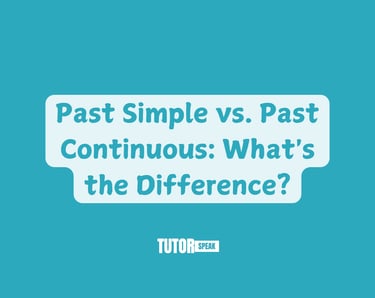Past Simple vs. Past Continuous: What's the Difference?
When talking about the past in English, we use different tenses to describe actions that happened at different times or under different circumstances. The Past Simple and Past Continuous tenses are both used to talk about past events, but they serve different purposes. Understanding when to use each tense is crucial for clear communication. In this article, we’ll explain the differences between Past Simple and Past Continuous, provide examples, highlight common mistakes with corrections, and give you exercises to help you master these tenses.
TutorSpeak
3 min read


Past Simple vs. Past Continuous: What's the Difference?
When talking about the past in English, we use different tenses to describe actions that happened at different times or under different circumstances. The Past Simple and Past Continuous tenses are both used to talk about past events, but they serve different purposes. Understanding when to use each tense is crucial for clear communication. In this article, we’ll explain the differences between Past Simple and Past Continuous, provide examples, highlight common mistakes with corrections, and give you exercises to help you master these tenses.
Past Simple vs. Past Continuous: Key Differences
1. Past Simple
The Past Simple tense is used to describe actions that happened and were completed at a specific point in the past. It is often used with time expressions like yesterday, last week, in 2000, two days ago, etc. It’s used for finished actions and events that happened at a particular moment in the past.
Examples:
I visited Paris last summer.
She finished her homework yesterday.
They played football last weekend.
Key Points:
Used for completed actions in the past: "I bought a new phone yesterday."
Used with time expressions such as yesterday, last year, in 2005: "We went to the beach last weekend."
Often used to describe a series of completed actions: "He woke up, had breakfast, and then left for work."
2. Past Continuous
The Past Continuous tense is used to describe actions that were in progress at a specific time in the past or to show that an action was happening at the same time as another action. It emphasizes the duration or the interruption of an action.
Examples:
I was reading a book when the phone rang. (Action in progress)
They were playing football when it started to rain. (Two actions happening at the same time)
She was studying all night for the exam. (Emphasis on the duration)
Key Points:
Used to describe actions that were happening at a specific moment in the past: "At 7 pm, I was cooking dinner."
Used for two actions happening simultaneously in the past: "I was watching TV while she was reading."
Often used with time expressions like at that moment, while, when: "I was working when she called."
Common Mistakes with Past Simple and Past Continuous
1. Mistake: "I was walked to the store yesterday."
Correction: "I walked to the store yesterday."
Explanation: The Past Simple should be used for a completed action in the past. "Was walked" is incorrect because the action is not continuous.
2. Mistake: "They played while we were eating."
Correction: "They played while we were eating."
Explanation: This sentence is correct. The Past Continuous is used to show two actions happening at the same time.
3. Mistake: "She was went to the market last night."
Correction: "She went to the market last night."
Explanation: The Past Simple is used for a specific completed action. "Was went" is incorrect because "went" is the past form of the verb and does not need to be in the continuous form.
4. Mistake: "I was seeing him yesterday."
Correction: "I saw him yesterday."
Explanation: Verbs like "see," "know," and "believe" are stative verbs, which do not typically take the continuous form.
Exercises to Practice Past Simple and Past Continuous
Exercise 1: Fill in the blanks with the correct form of the verb (Past Simple or Past Continuous).
I __________ (watch) TV when she __________ (arrive).
We __________ (have) a meeting at 3 pm yesterday.
They __________ (play) football when it __________ (start) raining.
He __________ (leave) his keys on the table last night.
I __________ (study) for my exam all evening yesterday.
We __________ (not/see) them at the party last weekend.
I __________ (read) a book when the lights __________ (go) out.
Exercise 2: Correct the mistakes in the following sentences.
She was went to the store when I called her.
They were watching a movie last night.
I was having lunch when the phone rang.
He study hard all day yesterday.
We were not understood the question at first.
Exercise 3: Choose the correct tense (Past Simple or Past Continuous).
I __________ (was reading / read) when the doorbell rang.
They __________ (visited / were visiting) their grandparents last weekend.
He __________ (was playing / played) the piano when we entered the room.
She __________ (watched / was watching) TV at 9 pm last night.
We __________ (were studying / studied) when the power went out.
Exercise 4: Write sentences using the following prompts (Past Simple or Past Continuous).
I / read / a book / when / the phone / ring
He / play / video games / at 8 pm / last night
they / not / work / when / I called / them
I / see / him / yesterday
We / walk / to the park / when / it / start / raining



